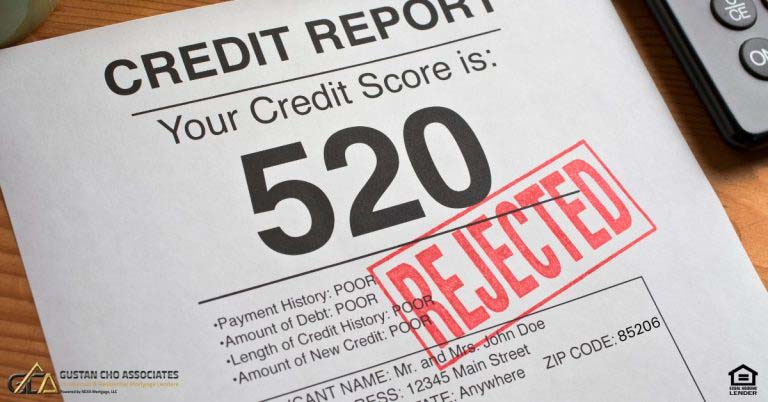Debt-to-Income Ratio Overlays: What Homebuyers Need to Know
Your debt-to-income ratio (DTI) matters to lenders when getting a mortgage. But here’s the catch: different lenders have their own set of rules. Some can add their own extra restrictions on top of the basic guidelines, and these extra rules are what we call debt-to-income ratio overlays.
In this guide, we’ll break down what DTI overlays are, how they affect your mortgage approval, and how to avoid them so you can qualify for a home loan, even with high debt. We’ll also show you how Gustan Cho Associates can help you get approved with no debt-to-income ratio overlays.
What Are Debt-to-Income Ratio Overlays?
Debt-to-income ratio overlays are additional rules that lenders create themselves. They’re stricter than the official DTI limits set by FHA, VA, USDA, Fannie Mae, or Freddie Mac.
Let’s say the FHA allows a borrower to have a DTI ratio up to 56.9%. A lender may decide to cap it at 45%. That extra limit is the lender’s overlay, not the FHA rule.
Lenders use overlays to lower their risk, but this can make things harder for borrowers who are already within the allowed guidelines.
DTI Ratio Overlays vs. Agency Guidelines—Understand the Difference
Learn how overlays impact your mortgage approval and how they differ from standard agency guidelines.
Why Do Lenders Have DTI Overlays?
Even though mortgage agencies set their own rules, lenders don’t have to follow them exactly. Lenders can add extra conditions because:
- They want to reduce risk
- Their investors demand it
- They had bad past experiences with high DTI loans
As a result, even if your loan would be approved under FHA or VA rules, a lender with overlays might deny you.
This is especially frustrating if you have a good income, stable job, and solid credit history, but your DTI is a little high.
How Debt-to-Income Ratio Is Calculated
To understand debt-to-income (DTI) ratio overlays, you must first know how DTI is calculated.
Mortgage lenders consider two kinds of DTI ratios when evaluating your financial situation. The Front-End DTI focuses on your future housing costs, which include your principal, interest, taxes, and insurance. The Back-End DTI gives a wider view by considering all your monthly debts, such as housing payments, credit card bills, student loans, car loans, and other obligations.
Then they divide your total monthly debt by your gross monthly income.
Example: If you make $5,000 a month before taxes and your total monthly debts are $2,500, your DTI is 50%.
Understanding both ratios is crucial for determining your ability to manage monthly payments and secure a loan.
2025 FHA Guidelines on DTI Ratios
In 2025, FHA guidelines allow you to have a maximum back-end DTI of 56.9% and a front-end DTI of 46.9% if your credit score is 620 or above. Your loan gets an “approve/eligible” status from automated underwriting (AUS). However, if your credit score is under 620, the FHA cuts the back-end DTI limit down to 43%, even if you have AUS approval. Remember, this is a guideline from the agency, not something set by individual lenders.
But here’s the catch: many lenders will not follow these maximums. They might deny your loan unless your DTI is 45% or lower, even though FHA allows more. That’s where debt-to-income ratio overlays come into play.
Real-World Examples of DTI Overlays
When considering real-world examples of debt-to-income (DTI) overlays, imagine you have a credit score 640 and a DTI of 54%. According to FHA guidelines, you would typically qualify for a loan. However, different lenders impose varying restrictions. For instance, Lender A allows a maximum DTI of only 45%, resulting in a denial of your application. Lender B has a slightly higher threshold at 50%, but you still face denial.
In contrast, Lender C, like Gustan Cho Associates, accepts DTI levels up to 56.9% without imposing overlays, which means you get approved. This illustrates just how significant an impact overlays can have on loan approval outcomes.
Confused About DTI Overlays? We’ll Help You Navigate Agency Guidelines
Understand how lender-specific overlays can affect your approval process and what agency guidelines require.
Common DTI Overlay Triggers
Lenders often apply debt-to-income ratio overlays in these situations:
- Credit score under 680: Some lenders won’t allow DTI above 43%-45% unless your credit is excellent.
- Manually underwritten loans: Even if the agency allows higher DTI on manual underwriting, many lenders limit it.
- Collections or charge-offs: Some lenders require you to pay off old debt even if FHA does not.
Overlays are not consistent. One lender might cap DTI at 43%, another at 50%, and another (like us) will go all the way to 56.9%—as long as AUS approves it.
Collection Accounts and DTI: What Borrowers Need to Know
If you have unpaid non-medical collection accounts totaling over $2,000, FHA guidelines stipulate that lenders must consider 5% of the balance when calculating your monthly debt, even if you are not making any payments on those accounts. For example, if you owe $3,000 in collections, the lender is required to add $150 per month to your debt-to-income (DTI) calculation, which is 5% of the $3,000 owed.
BUT—you can fix this by setting up a payment plan with the collection agency. Then the lender will count your actual monthly payment, not 5% of the total.
Lenders with overlays may still deny you, even if you follow this FHA guideline. But Gustan Cho Associates follows FHA guidelines only, with no overlays.
DTI Overlays on Charge-Off Accounts
FHA does not require paying off charge-off accounts to qualify for a loan. But many lenders with overlays do.
These lenders may say:
- “We won’t approve your loan unless all charge-offs are paid.”
- “We cap DTI at 43% no matter what.”
These are overlays. If your loan meets FHA guidelines, you deserve a chance to qualify without jumping through extra hoops.
How to Avoid Debt-to-Income Ratio Overlays
Avoid lenders with overlays if you have a high DTI, collections, or a low credit score.
Here’s how:
- Ask upfront: What’s your DTI limit? Do you follow FHA/VA/USDA guidelines or have your own rules?
- Shop around: Don’t assume all lenders are the same.
- Work with a lender with no overlays, like Gustan Cho Associates.
We work with borrowers who have been denied elsewhere, simply because their lender had overlays.
Get Approved with No DTI Overlays
At Gustan Cho Associates, we believe you should be approved if you meet agency guidelines. We don’t add extra DTI overlays. Here’s what that means for you:
- Up to 56.9% DTI on FHA loans with credit scores of 620+
- 43% DTI on FHA loans with credit scores under 620 (as allowed by FHA)
- Manual underwriting allowed with compensating factors
- No overlays on collections or charge-offs if FHA doesn’t require it
We say YES when banks and big lenders say NO. Approved. Period.
Know the Impact of DTI Ratio Overlays on Your Mortgage
Find out how different lenders apply DTI overlays and what you can do to qualify based on agency guidelines.
Final Thoughts: Don’t Let Overlays Kill Your Mortgage Dreams
Debt-to-income ratio overlays stop thousands of borrowers from getting approved yearly, even though they technically qualify.
Don’t settle for a lender that says your DTI is too high. Find one that follows the actual mortgage guidelines, not their made-up rules. That’s what we do every day at Gustan Cho Associates.
Need Help? Contact Us
If you’ve been told your DTI is too high, or you’re just starting the process and want to avoid surprises, reach out today.
Borrowers who need a five-star national mortgage company licensed in 50 states and who are experts on debt-to-income ratio overlays, please contact us at 800-900-8569, text us for a faster response, or email us at alex@gustancho.com.
We’re available 7 days a week—evenings, weekends, and holidays—to help you get approved. Let us fight for your home loan approval. Don’t let overlays stand in your way.
Frequently Asked Questions About Debt-to-Income Ratio Overlays:
Q: What are Debt-to-Income Ratio Overlays?
A: Debt-to-income ratio overlays are extra rules that some lenders add to standard mortgage guidelines. For example, even if FHA allows a 56.9% DTI, a lender might only allow 45%. That’s their overlay, not FHA’s rule.
Q: Why do Some Lenders have Debt-to-Income Ratio Overlays?
A: Lenders use debt-to-income ratio overlays to protect themselves from risk. They might have had bad experiences with high-DTI loans, or their investors require stricter rules.
Q: Can I Still Get a Loan if My DTI is High?
A: Yes! If your loan meets FHA or VA rules, you can still qualify. You just need to work with a lender like Gustan Cho Associates that doesn’t have debt-to-income ratio overlays.
Q: How Can I Avoid Debt-to-Income Ratio Overlays?
A: Ask lenders upfront if they follow agency guidelines or have overlays. Then, work with a lender like Gustan Cho Associates, which has no debt-to-income ratio overlays.
Q: What’s the Highest DTI Allowed with no Overlays?
A: For FHA loans in 2025, the maximum DTI is 56.9% (back-end) and 46.9% (front-end) with credit scores 620+. Gustan Cho Associates allows this with no debt-to-income ratio overlays.
Q: Do Unpaid Collections Affect My DTI?
A: Yes—if you have over $2,000 in non-medical collections, lenders must count 5% of the balance into your DTI. However, with a payment plan, only the monthly payment counts. Overlays may make this harder, but lenders with no debt-to-income ratio overlays follow the FHA rule only.
Q: Do I Need to Pay Off Charge-Offs to Get Approved?
A: Not with FHA loans. However, some lenders with overlays may still require it. At Gustan Cho Associates, we follow FHA guidelines only and don’t require charge-offs to be paid if the agency doesn’t.
Q: What if My Credit Score is Under 620?
A: If your score is under 620, FHA allows up to 43% DTI. Some lenders still add overlays and want even lower DTI. Gustan Cho Associates sticks with FHA rules, with no added debt-to-income ratio overlays.
Q: Do Overlays Apply to Manually Underwritten Loans?
A: Yes. Some lenders apply stricter overlays to manual underwriting. If you meet compensating factors, Gustan Cho Associates allows manual underwriting up to FHA limits without debt-to-income ratio overlays.
Q: What Happens if My Lender Denies Me Because of High DTI?
A: If your lender has overlays, they might say no, even if you qualify under FHA or VA rules. Don’t give up. Contact a lender without debt-to-income ratio overlays, like Gustan Cho Associates, to get approved.
This blog about “Debt-To-Income Ratio Overlays Versus Agency Guidelines” was updated on July 17th, 2025.
DTI Overlays vs. Agency Guidelines: Which One Applies to You?
We’ll help you compare overlays and agency guidelines to find the best path to approval.










